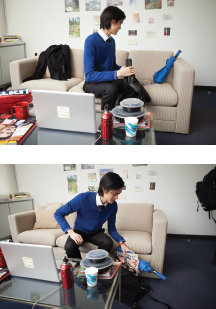Sample Student Persuasive Speech 16.1
Preventing Cyberbullying
ELIJAH LUI

On the evening of September 22, 2010, Rutgers University freshman Tyler Clementi updated his Facebook status: “Jumping off the gw [George Washington] bridge sorry.” According to Lisa Foderaro’s report in The New York Times, a few hours later Clementi did just that. But what would cause a bright student and talented musician with a promising future to take his own life? A bully with a webcam.
Elijah begins his speech with a dramatic example that captures the audience’s attention.
According to a May 21, 2012, report on CNN, Clementi’s roommate was sentenced to 30 days in jail, 3 years of probation, 300 hours of community service, and $11,000 in restitution for using a Web cam to view and transmit images of Clementi in an intimate encounter with another young man. Tyler Clementi’s story is tragic, but it’s not an isolated event. On September 9, 2013, 12-
Elijah introduces his topic with a rhetorical question.

My name is Elijah, and I’m here today to confront the growing problem of electronic harassment experienced by Tyler Clementi and so many others. I’ll start with a look at the various forms cyberbullying takes and describe the scope of the problem. But I’m not here just to talk about one more social ill; I want to show you how you and your loved ones can stay safe—
Elijah sets up the organizational pattern of the speech, indicating that he will describe a problem and offer solutions.
As you can imagine from the heartbreaking story I’ve shared about Tyler Clementi, cyberbullying poses serious mental health risks to the nation’s children, teens, and young adults. The Cyberbullying Research Center, a leading resource on the topic, defines cyberbullying as “willful and repeated harm inflicted through the use of computers, cell phones, and other electronic devices.” Cyberbullying can take many forms, including posting or sending harassing messages via Web sites, blogs, or text messages; posting embarrassing or private photos of someone without their permission; recording or videotaping someone and sharing it without permission; and creating fake Web sites or social networking profiles in someone else’s name to humiliate them. Often these acts are done anonymously.
Elijah qualifies his source and demonstrates its credibility.
Elijah begins the body of his speech by ensuring that his audience knows what cyberbullying means.
Recent research paints a chilling picture of the frequency and harm of electronic harassment. According to Hani Morgan, an education professor at the University of Southern Mississippi, the statistics vary widely, but a 2011 report by the National Crime Prevention Council found that 43 percent of teens had been the victims of cyberbullying in the last year. Although most of the research to date has focused on cyberbullying among middle school and high school students, a 2012 study published in the Journal of School Violence confirmed that the problem of electronic harassment continues into college. Psychologists Allison Schenk and William Fremouw found that nearly 9 percent of university students had experienced cyberbullying; that means that at least two or three people listening to this speech know what I’m describing because they’ve felt it. As we have seen with Tyler, Rebecca, Rehtaeh, and too many others, cyberbullying has tragically cut short promising lives. But consequences less dramatic than suicide take a serious toll on cyberbullying’s victims. The same study by Schenk and Fremouw reported more symptoms of depression and anxiety, as well as difficulty concentrating, among bullied college students.
Elijah effectively puts his research to work throughout this section, making sure to give credit to his reputable sources.

As Professor Morgan explains, the anonymity of unsigned messages and fake user names marks cyberbullying as a dangerous evolution of a long-
Elijah effectively transitions to offering solutions and practical steps avoid cyberbullying.
In addition to zealously guarding your personal information, you can help combat cyberbullying by being a voice against it whenever you see it happening. Several organizations have Web sites that provide information you can use to be part of the solution. The Facebook group Don’t Stand By, Stand Up! is a student-
This transition summarizes the previous point and previews the next one.
Online safety expert Parry Aftab’s Web site, Stopcyberbullying.org, advises victims to use the “Stop, Block, and Tell” method to respond to bullying behaviors directed against them. Though often taught to younger children, this response makes sense in any case of cyberbullying. After receiving a bullying message, you should first stop. In other words, do nothing. Take five minutes to cool down, take a walk, breathe deeply, or do whatever will help to calm down the understandable anger you are feeling. Then, block: prevent the cyberbully from having any future communication with you. This may mean anything from removing him or her from your social networking site’s “friends” list to having your cell phone service provider block the bully from being able to call or text you. The third step is to tell someone about the abuse without embarrassment or shame. For example, you might call campus security or confide in a counselor at the Health and Counseling Center—
Today we’ve ventured into the very real—
Elijah signals the conclusion of his speech with a summary of his main points.

Cyberbullying isn’t just someone else’s problem. It’s very likely something you need to guard against now or in the future—
Elijah issues a call to action.
We must never forget Tyler Clementi and the other young lives cut short by unnecessary bullying. Who knows? Your best friend, your younger brother, or your son could just have easily been on that bridge that fateful September evening.
By stressing the personal relevance of his topic to his audience, Elijah leaves his listeners with something to think about.
References
Foderaro, L. W. (2010, September 30). Private moment made public, then a fatal jump. The New York Times. Retrieved from http:/
Hayes, A. (2012, May 21). Prosecutors to appeal 30-
Hinduja, S., & Patchin, J. W. (2010). Cyberbullying: Identification, prevention, and response [Fact Sheet]. Retrieved from www.cyberbullying.us/
Martinez, M. (2013, October 28). Charges in Rebecca Sedwick’s suicide suggest “tipping point” in bullying cases. Retrieved from www.cnn.com/
Morgan, H. (2013, May/June). Malicious use of technology: What schools, parents, and teachers can do to prevent cyberbullying. Childhood Education, 89(3), 146–
Newton, P. (2013, April 10). Canadian teen commits suicide after alleged rape, bullying. Retrieved from www.cnn.com/
Schenk, A. M., & Fremouw, W. J. (2012, January). Prevalence, psychological impact, and coping of cyberbully victims among college students. The Journal of School Violence, 11(1), 21–
Stop, block and tell! (n.d.). Retrieved November 1, 2013, from www.stopcyberbullying.org/
Stop cyberbullying before it starts. (n.d.). Retrieved February 9, 2011, from www.ncpc.org/